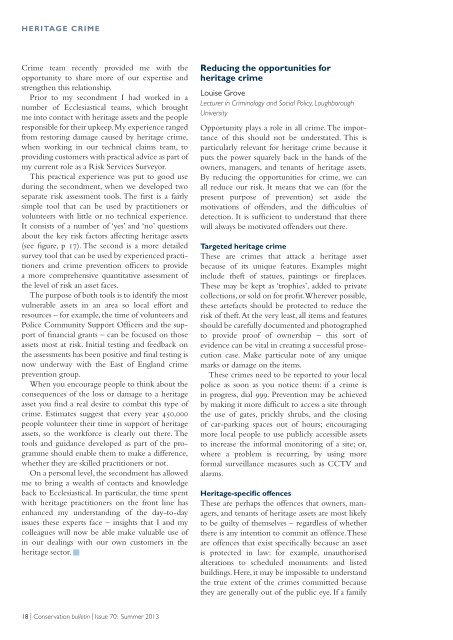Conservation Bulletin 70 | PDF - English Heritage
Conservation Bulletin 70 | PDF - English Heritage
Conservation Bulletin 70 | PDF - English Heritage
Create successful ePaper yourself
Turn your PDF publications into a flip-book with our unique Google optimized e-Paper software.
HERITAGE CRIME<br />
Crime team recently provided me with the<br />
opportunity to share more of our expertise and<br />
strengthen this relationship.<br />
Prior to my secondment I had worked in a<br />
number of Ecclesiastical teams, which brought<br />
me into contact with heritage assets and the people<br />
responsible for their upkeep. My experience ranged<br />
from restoring damage caused by heritage crime,<br />
when working in our technical claims team, to<br />
providing customers with practical advice as part of<br />
my current role as a Risk Services Surveyor.<br />
This practical experience was put to good use<br />
during the secondment, when we developed two<br />
separate risk assessment tools. The first is a fairly<br />
simple tool that can be used by practitioners or<br />
volunteers with little or no technical experience.<br />
It consists of a number of ‘yes’ and ‘no’ questions<br />
about the key risk factors affecting heritage assets<br />
(see figure, p 17). The second is a more detailed<br />
survey tool that can be used by experienced practitioners<br />
and crime prevention officers to provide<br />
a more comprehensive quantitative assessment of<br />
the level of risk an asset faces.<br />
The purpose of both tools is to identify the most<br />
vulnerable assets in an area so local effort and<br />
resources – for example, the time of volunteers and<br />
Police Community Support Officers and the support<br />
of financial grants – can be focused on those<br />
assets most at risk. Initial testing and feedback on<br />
the assessments has been positive and final testing is<br />
now underway with the East of England crime<br />
prevention group.<br />
When you encourage people to think about the<br />
consequences of the loss or damage to a heritage<br />
asset you find a real desire to combat this type of<br />
crime. Estimates suggest that every year 450,000<br />
people volunteer their time in support of heritage<br />
assets, so the workforce is clearly out there. The<br />
tools and guidance developed as part of the programme<br />
should enable them to make a difference,<br />
whether they are skilled practitioners or not.<br />
On a personal level, the secondment has allowed<br />
me to bring a wealth of contacts and knowledge<br />
back to Ecclesiastical. In particular, the time spent<br />
with heritage practitioners on the front line has<br />
enhanced my understanding of the day-to-day<br />
issues these experts face – insights that I and my<br />
colleagues will now be able make valuable use of<br />
in our dealings with our own customers in the<br />
heritage sector. ■<br />
Reducing the opportunities for<br />
heritage crime<br />
Louise Grove<br />
Lecturer in Criminology and Social Policy, Loughborough<br />
University<br />
Opportunity plays a role in all crime.The importance<br />
of this should not be understated. This is<br />
particularly relevant for heritage crime because it<br />
puts the power squarely back in the hands of the<br />
owners, managers, and tenants of heritage assets.<br />
By reducing the opportunities for crime, we can<br />
all reduce our risk. It means that we can (for the<br />
present purpose of prevention) set aside the<br />
motivations of offenders, and the difficulties of<br />
detection. It is sufficient to understand that there<br />
will always be motivated offenders out there.<br />
Targeted heritage crime<br />
These are crimes that attack a heritage asset<br />
because of its unique features. Examples might<br />
include theft of statues, paintings or fireplaces.<br />
These may be kept as ‘trophies’, added to private<br />
collections, or sold on for profit.Wherever possible,<br />
these artefacts should be protected to reduce the<br />
risk of theft.At the very least, all items and features<br />
should be carefully documented and photographed<br />
to provide proof of ownership – this sort of<br />
evidence can be vital in creating a successful prosecution<br />
case. Make particular note of any unique<br />
marks or damage on the items.<br />
These crimes need to be reported to your local<br />
police as soon as you notice them: if a crime is<br />
in progress, dial 999. Prevention may be achieved<br />
by making it more difficult to access a site through<br />
the use of gates, prickly shrubs, and the closing<br />
of car-parking spaces out of hours; encouraging<br />
more local people to use publicly accessible assets<br />
to increase the informal monitoring of a site; or,<br />
where a problem is recurring, by using more<br />
formal surveillance measures such as CCTV and<br />
alarms.<br />
<strong>Heritage</strong>-specific offences<br />
These are perhaps the offences that owners, managers,<br />
and tenants of heritage assets are most likely<br />
to be guilty of themselves – regardless of whether<br />
there is any intention to commit an offence.These<br />
are offences that exist specifically because an asset<br />
is protected in law: for example, unauthorised<br />
alterations to scheduled monuments and listed<br />
buildings. Here, it may be impossible to understand<br />
the true extent of the crimes committed because<br />
they are generally out of the public eye. If a family<br />
18 | <strong>Conservation</strong> bulletin | Issue <strong>70</strong>: Summer 2013

















